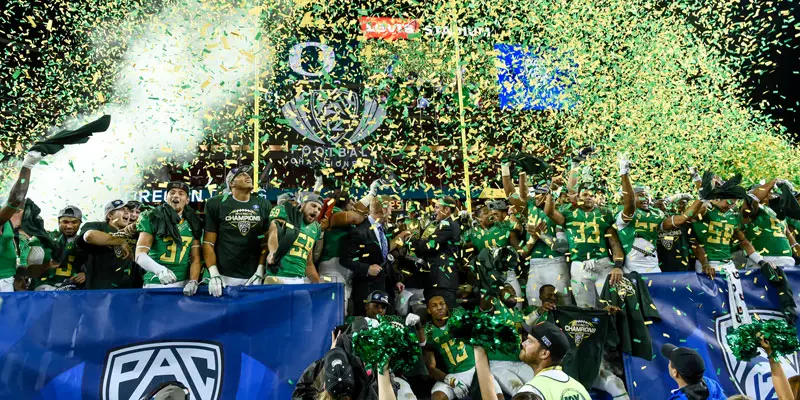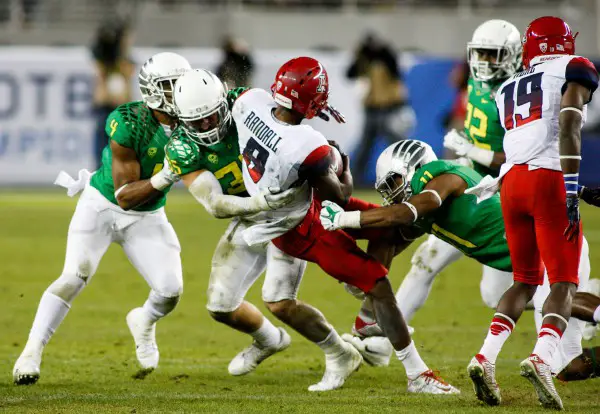America’s Team
Last week, I wrote that Oregon’s likeliest path (if the Ducks kept playing) was a dream scenario of games against Arizona, Florida State, and Alabama. Then the Selection Committee decided to jump TCU up to three last Tuesday, trying to ruin everyone’s good time in the process. In the end, logic prevailed (depending on your perspective), and that gave college football two perfect matchups for the Playoff semifinals — an opinion I hold only because my team is in.
(I’d like to pass along a “sorry not sorry” to the Big 12, the conference whose politicking kept Oregon out of a National Championship Game in 2001 and a BCS bowl in 2005.)
The Ducks finally get to play Florida State in a true good-vs.-evil matchup; the first-ever between the schools. Back in October, Oregon was declared college football’s most popular team, and that was before it ever had a game scheduled against Florida State. With the Seminoles on the schedule, the Ducks are certain to be America’s team on January 1st.
Oregon was definitely the biggest beneficiary of the new playoff setup. Under the old BCS system, Oregon certainly would have been left out as the third place team, because the system likely would have paired Florida State (for being undefeated) and Alabama (for being in the SEC). Now instead of being left out under the old BCS system, Oregon has a chance (in fact, the best chance) at winning a national championship.
Even When Dreams Are Realized, We Can Never Predict The Path
The end of Friday night’s game proved one thing: Even if your dreams are realized, you can never predict how they will play out.
Imagine if you told an Oregon fan in January 2011 that the top-ranked quarterback in Oregon’s recruiting class that year would score a touchdown on the game’s final play, the Ducks would win the Pac-12, and as a result would have the best odds of winning the national championship. There would obviously have been elation among Oregon fans, but also the assumption that the play itself would have resulted in some big finish for the Ducks.
No one could have predicted that instead of a dramatic ending, that top-ranked quarterback would be scoring that touchdown in garbage time as the third-string quarterback … for a conference rival. Yet such was the path for Jerrard Randall.
Of the three quarterbacks who committed to the Ducks in the 2011 recruiting class, Randall was the most highly regarded of the three, the other two being Johnny Manziel and Marcus Mariota. Yet if you had told an Oregon fan only one of those three commits wouldn’t win a Heisman Trophy by the end of 2014, they would first be astounded that somehow two Oregon commits would win Heisman Trophies. Then they would probably say, “Let me guess: Two of those commits never even arrive in Eugene, huh?” and you would watch their heads drop when you would tell them “yes.” But then you would pick their heads up by saying “but one of them will (likely) win it as a Duck!” Even then few would have predicted it would have been the least heralded of the three (Mariota) who would pull it off with only the four-star quarterback Randall left without a trophy.
In the same way that players’ career paths can’t be predicted, neither can we predict how seasons will play out. While I spent much of the season predicting the chaos of 2007 playing out again this year, that chaos disappeared over the second half of the season. Instead, this year more closely mirrored 2009, when a cluster of five or six top teams separated themselves from the rest of college football. While many Oregon fans could have dreamed of a conference championship and a playoff berth, few would have expected that Arizona would have presented a greater obstacle to that dream than Michigan State, Stanford, or UCLA. And those who watched what unfolded on October 2nd never could have expected that Oregon would get a chance at revenge before the series between the two teams goes into regular season hiatus until 2017.
About That Venue…
Give a lot of credit to Fox Sports, who did its best to hide a half-empty Levi’s Stadium by cutting to another shot every time the seats themselves were about to become visible. The official attendance announced for Friday’s game was 45,618 or just around 14,000 fewer than the attendance at Oregon’s last appearance in the conference championship in 2011. It was also is 24,000 fewer attendees than last year’s game in Tempe, and was bested (worsted?) in lack of attendance only by the 2012 Championship Game, hosted by the notoriously die-hard community that is the Stanford Cardinal.
To review attendance for the conference’s Championship by geographic location:
Average attendance for games played in Santa Clara County: 38,620
Average attendance for games played outside Santa Clara County: 64,456
Based on the selection committee’s omission of Big 12 teams, the necessity of a conference championship game is evident. But why replicate the attendance disaster other conferences have shown in their championship games?
If you followed the Pac-12’s Twitter feed last week (and why wouldn’t you!), the intent of this decision was made apparent: instead of mirroring the energy of the SEC’s event, the conference chose to relocate its nascent event to the country’s most technologically advanced stadium so we could have a tech conference and say things like this:
“The ultimate call to action is the hashtag. It makes it so easy for the fan and user.” –@jennihogan
— Pac-12 Conference (@pac12) December 4, 2014
Oh, FFS. It’s a football game. The Pac-12 doesn’t need to do research or hold panels to figure out how to maximize a game experience, I’ll tell you in the answer in one sentence: Create a desirable tailgating setting, set the prices at the optimal level to fill the seats, and get enough bandwidth for fans to upload their pics and download their scores. That’s it. Telling fans what they want is ignorant at best and insulting at worst.
Larry Scott has said it was necessary to experiment with having the game at Levi’s Stadium. Fine, you had your experiment, and it went poorly. (If only some sagely writer could have warned you of this months ago!) The attendance was poor, the playing surface was garbage (you know, the field, the thing that needs to be in decent shape to keep your playoff candidates’ players healthy enough to actually win a championship for the conference), and at a time when it would be in the best interest of public relations to not have a police controversy … your championship game predictably went and had a controversy.
Get the games back on campus. Unless that campus happens to be Stanford, they’re better attended than at neutral sites, and it doesn’t look like Stanford is going to be winning a division any time soon. You can’t go out and brag about the quality of your member institutions and then imply that their facilities aren’t suitable for hosting a marquee event. The conference has teams worthy of the nation’s attention. Put the games in venues that show fans want to be there.
Top image by Craig Strobeck.
Related Articles:
Chip Kelly Update: Everything's Good Again ...
Chip Kelly Update: Wailing and Gnashing of Teeth
Shock and Awe -- The Oregon Ducks' Football Hangover Effect
Despite Lopsided Score, Georgia State "Never Stopped Believing"
Hope Springs Eternal for Ducks
Incompetent Pac-12 Officials: How Do You Miss ALL of THIS?
Nathan Roholt is a senior writer and managing editor emeritus for FishDuck. Follow him on Twitter @nathanroholt. Send questions/feedback/hatemail to nroholtfd@gmail.com.



